How to Bleed Your Cars Cooling System
In this article we are going to look at the issue of air in your cooling system. Simply put it should not be there and if you have this issue you will need to take steps to fix it. This will likely include bleeding the coolant system and refilling it so read on to find out how you would do this.
Why Is Air in The Cooling System Bad?
In modern vehicles the engine cooling system is a liquid based one. This is a fluid known as coolant or antifreeze that is mostly water but also has other chemicals in it to increase the water's boiling point.
This fluid circulates the engine in a closed system pulling heat away from the engine before entering the radiator where it is cooled back down. This circulation of fluid cools down the engine to its optimum running temperature range.
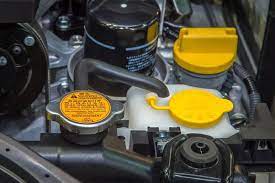
If you get air bubbles in the coolant system however you start to have a problem. The air does not hold the heat as well as the coolant so it means the cooling system is not working at its peak efficiency. This can lead to your engine overheating.
An overheated engine quickly starts to become damaged and this could end up costing a huge amount in repairs.
How Does Air Get in The Coolant System?
The most common cause of air bubbles in your coolant system is low coolant levels. If you have a leak or your coolant has just gradually burned off over time air can start to get into the system. If your coolant levels are starting to get low you will want to top them up.
Running for an extended period with low coolant can allow a lot of air to enter the system and this is a very bad thing. If you think you have air in your coolant system you may need to fully bleed it and refill with fresh coolant.
What Are The Methods for Bleeding the Coolant System?
There are only two methods to drain a coolant system so your options are simple.
Manual Method
This is the old school method and generally one that is not too complicated to achieve. Your car should have one or more bleed valves that are designed to allow you to release air from the system. If your car does not have these valves it will become a little more complicated.
Vacuum Method
This is a more up to date method of bleeding the system which will require some specialized equipment including a vacuum tool and possibly an air compressor. This method creates a vacuum in the system that pulls out the air and allows coolant to refill the space.
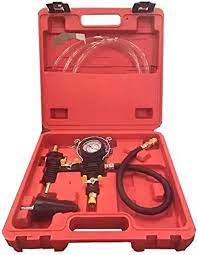
It is the most efficient method by far assuming you have the right equipment. It can take less than a minute if done correctly. But if you do not have the tools you will likely need the help of a mechanic.
How to Bleed Your Car's Cooling System
As the old school manual method is by far the most complex to perform we will give you a quick run through of how you do this. Before we start, be warned coolant heats up quickly so take special care while doing this.
1. Prepare Your Coolant
This is an important first step and can be complicated in itself. You will first want to make sure you have coolant ready to reintroduce to your cooling system. Refer to your car's user manual to make sure you have the right type of coolant.
If the coolant needs to be diluted before use then follow the supplied instructions to create the correct mixture. This is often a 50/50 mix of coolant solution and water but it can vary based on your type of car and your general climate.
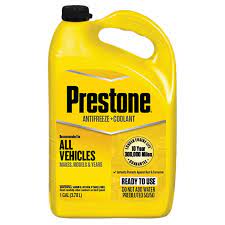
If you get the mixture wrong in a cold climate your coolant can freeze in the engine and this is a very bad thing to have happen.
2. Jack Up the Car (Optional)
This is a step that although not strictly necessary can still be beneficial to get the job done efficiently. If you choose to do so safely jack up the front of your car this will actually help you bleed the air more quickly when you reach that point.
You can either use a floor jack or you can park the car on a slight upward incline to get the same result. If you use floor jacks however remember to use jack stands. You will not be under the car at any point but you could still have the car drop on your foot and that would not be a fun experience.
3. Fill the Coolant
With your prepared coolant solution it is now time to refill the coolant tank. If your car has bleed valves, open them while you are refilling the coolant tank and take it all the way up to the max line. If coolant begins to come out of the valves, close them again quickly.
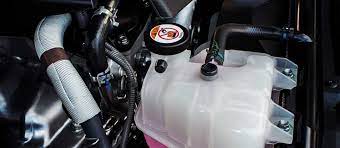
As a general warning coolant is toxic so if you do spill some clean it up especially if it makes it to the road surface. It can be poisonous to animals and if they were to drink it they could become very sick and even die so be responsible.
4 Start the Engine
Ideally for this next step you should have a second person to help but this may not be possible. What you will do is start the engine and if you have a friend who will start it for you you can stand back from the engine and watch to see if coolant gets pushed out from the radiator. If this happens then there is definitely air in the system.
5. Turn the Heat Up
This may seem like an odd step but trust us there is a reason for this. With the engine running, turn your climate control heat all the way up. The reason you choose heat over cooling is that in some vehicles there may be a valve to restrict coolant from flowing inside the car's thermal pack if the temperature is set to cold.
Other cars are different and they direct the airflow and not the coolant flow so no matter which type of system you have, setting it to hot will always achieve this next step.
6. Rev Your Engine
Again this is best done with a friend so you can see what is happening under the hood while you do this step. Have your friend rev your engine to around 3000 – 4000 RPMs and hold steady at that. You will want to work quickly to avoid the coolant heating up.
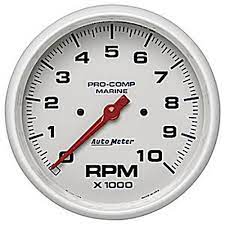
7. Open Bleed Valves
With the engine revving very carefully start to loosen the air bleeding valves. Be aware the engine activity may cause coolant to come out of the valves and it may be hot. Once you see liquid coming out of the valves, close them up again. Repeat this process a couple of times until the liquid starts to come out straight away. Any delay means that air is still coming out of the system first.
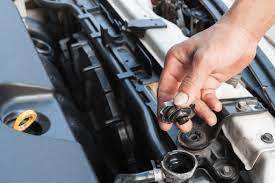
8. Refill the Coolant Tank
The first top up was to make sure there was enough coolant in the system to replace the air pockets. Now that you have bled the air you may notice that the coolant tank is no longer filled to the max line.
Making sure your bleed valves are closed put the car in idle and refill the coolant tank. You can also now lower the car if you had it jacked up. While still idling watch to see if the coolant tank goes down more and if the heating is working in your car.
Once you have a coolant temp reading of 194 degrees Fahrenheit you can close the radiator cap and your car should be free of air in the coolant system.
9. Test Your car Out
The only true way to be sure this has all worked is to make sure the coolant system is now working at its best again. Go out for a long test drive keeping an eye on the engine temperature gauge. You should not even come close to overheating as long as everything worked.
10. Check the Coolant Level One Last Time
After the drive ideally the coolant level in the tank should be the same as when you left. If it has significantly dropped you may have a coolant leak which is now a separate problem for you to fix.
Conclusion
If you have an older car bleeding the coolant tank is a complex procedure that should take about 30 minutes roughly. In modern cars you do not have the bleed valves anymore but clever equipment can help you bleed the system in around 1 minute which is much easier.
Link To or Reference This Page
We spend a lot of time collecting, cleaning, merging, and formatting the data that is shown on the site to be as useful to you as possible.
If you found the data or information on this page useful in your research, please use the tool below to properly cite or reference Tow Ratings as the source. We appreciate your support!
-
<a href="http://towratings.net/blog/how-to-bleed-your-cars-cooling-system/">How to Bleed Your Cars Cooling System</a>
-
"How to Bleed Your Cars Cooling System". Tow Ratings. Accessed on April 25, 2024. http://towratings.net/blog/how-to-bleed-your-cars-cooling-system/.
-
"How to Bleed Your Cars Cooling System". Tow Ratings, http://towratings.net/blog/how-to-bleed-your-cars-cooling-system/. Accessed 25 April, 2024
-
How to Bleed Your Cars Cooling System. Tow Ratings. Retrieved from http://towratings.net/blog/how-to-bleed-your-cars-cooling-system/.